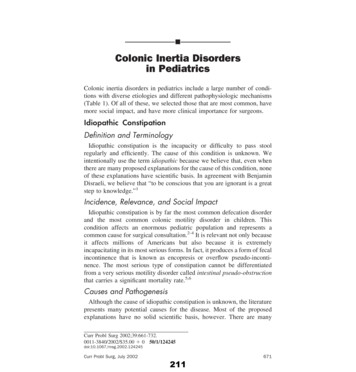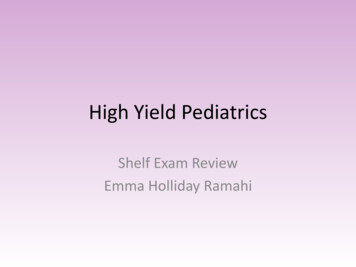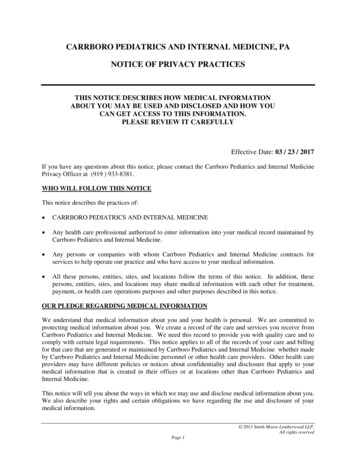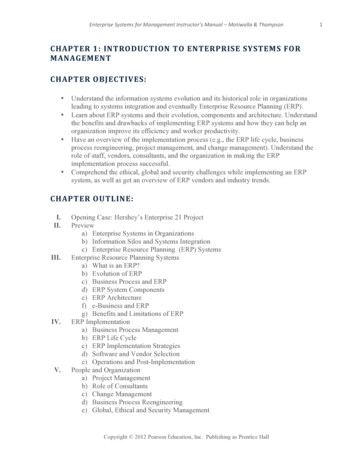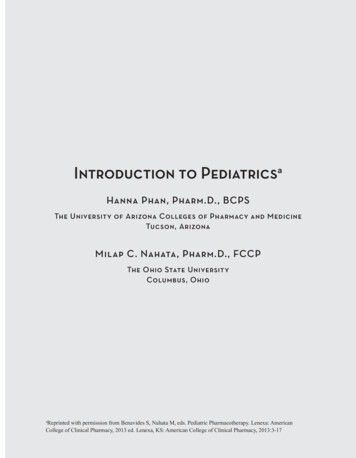
Transcription
Introduction to PediatricsaHanna Phan, Pharm.D., BCPSThe University of Arizona Colleges of Pharmacy and MedicineTucson, ArizonaMilap C. Nahata, Pharm.D., FCCPThe Ohio State UniversityColumbus, OhioReprinted with permission from Benavides S, Nahata M, eds. Pediatric Pharmacotherapy. Lenexa: AmericanCollege of Clinical Pharmacy, 2013 ed. Lenexa, KS: American College of Clinical Pharmacy, 2013:3-17a
Introduction to Pediatric PharmacyIntroduction to PediatricsaHanna Phan, Pharm.D., BCPSThe University of Arizona Colleges of Pharmacy and MedicineTucson, ArizonaMilap C. Nahata, Pharm.D., FCCPThe Ohio State UniversityColumbus, OhioReprinted with permission from Benavides S, Nahata M, eds. Pediatric Pharmacotherapy. Lenexa: AmericanCollege of Clinical Pharmacy, 2013 ed. Lenexa, KS: American College of Clinical Pharmacy, 2013:3-17aACCP Updates in Therapeutics 2018: Pediatric Pharmacy Preparatory Review and Recertification Course931
Introduction to Pediatric PharmacyLearning Objectives1.2.3.4.5.Define the different age groups and correspondingdevelopmental milestones in pediatric patients.Describe differences in vital signs and laboratorynormal values based on age.Describe fundamental differences between pediatricand adult patients regarding drug therapy, includingavailability of treatment options, clinical data, andadministration challenges.Define off-label medication use and its implicationsin pediatric drug therapy.Apply general pharmacotherapeutic concepts andpediatric-specific factors toward providing care andeducation to patients and families.AbbreviationsAAPAmerican Academy of PediatricsBMIBody mass indexCDCCenters for Disease Control and PreventionGFRGlomerular filtration ratePDPharmacodynamicsPKPharmacokineticsWHO World Health OrganizationACCP Updates in Therapeutics 2018: Pediatric Pharmacy Preparatory Review and Recertification Course932
Introduction to Pediatric PharmacyI. THE ROLE OF A PEDIATRIC PHARMACISTPediatric patients are not simply “smaller adults”; they make up their own population with a need for specializedpatient care (Reference 1). Pediatric pharmacy practice focuses on the provision of safe and effective drug therapyin infants, children, and adolescents. As such, the American Society of Health-System Pharmacists (ASHP) recognizes the specialized nature of pediatric pharmacy practice through its statement regarding pediatric pharmaceutical services and its accreditation of specialized postgraduate training programs in pediatric pharmacy practice(References 2–4). The Pediatric Pharmacy Advocacy Group (PPAG) composed a response in support of the ASHPstatement. Also noteworthy are the PPAG position statements regarding pediatric pharmacy practice, including therole of pediatric pharmacists in personalized medicine and clinical pharmacogenomics (References 3, 5, 6). TheAmerican College of Clinical Pharmacy (ACCP) also supports pediatric pharmacy practice through the PediatricPractice Research Network and contributions such as the opinion paper about pediatric pharmacy education andtraining (Reference 7). Drug selection and use, monitoring of effectiveness and toxicity, prevention of medicationerrors, patient/caregiver education, and contributions to knowledge through research are among the responsibilitiesof pharmacists when caring for pediatric patients (Reference 8). Likewise, other professional organizations supportthe role of pharmacists in pediatric patient care. The American Academy of Pediatrics (AAP) acknowledges theimportance of interdisciplinary teams in pediatric patient care. In fact, the AAP recommends that prescribers usepharmacist consultation, when available, including the integration of clinical pharmacists in patient care roundsand activities that involve reviewing medication use procedures and orders (Reference 9).Pharmacists who care for pediatric patients should possess knowledge regarding disease states and drugtherapy as well as the skills to apply this knowledge to practice. Pediatric practice includes a wide range ofpatient ages, with conditions varying from lower respiratory tract infection to trauma. Chronic disease statesinclude lifelong or long-term diseases, such as type 1 diabetes mellitus, asthma, or congenital heart disease.II. CLASSIFICATION OF PEDIATRIC PATIENTSPediatric patients are a specialized patient population. Their ages are expressed in days, weeks, months, or years.General classification is often age-dependent. Neonates are the patients from birth to younger than 28 days (4weeks) of life when born full term, whereas infants are those 28 days to younger than 12 months. Children areoften defined as 1–12 years of age. Adolescents can vary in definition, but they are most often recognized as age13–17 years. Some government agencies combine adolescents with young adults who are up to 24 years of age(References 1, 10–12). Additional classifications are based on other factors such as birth weight and gestationalage. For example, “low birth weight” is defined as having a birth weight between 1500 and less than 2500 g, and“premature” is defined as being born before 37 weeks of gestational age (Reference 10). An appreciation of theclassification of pediatric patients is important in guiding medication selection because some medications are contraindicated for patients of certain ages. Medication dosing can also be affected by such classifications becausedosing may depend on organ function (e.g., kidney or liver) development, which progresses with age. For example,neonates and infants lack the ability to metabolize alcohol by alcohol dehydrogenase, whereas adults have this ability. Thus, the use of elixir formulations should be avoided whenever possible in infants (Reference 13).III. UNIQUENESS OF PEDIATRIC PHARMACOTHERAPYPediatric patients are unique because of their differences in regards to pharmacokinetics and pharmacodynamics(PK/PD), psychosocial influences on drug therapy selection, and treatment options from their adult counterparts.Developmental changes in PK/PD affect drug therapy selection and dosage requirements in the pediatric agecontinuum, from birth to 18 years. Pediatric clinicians must also consider factors that affect caregiver medication administration hesitance. These include cultural beliefs, socioeconomic status, and psychosocial differencesACCP Updates in Therapeutics 2018: Pediatric Pharmacy Preparatory Review and Recertification Course933
Introduction to Pediatric Pharmacyamong age groups (e.g., child vs. adolescent). Pediatric patients also require special consideration when usingspecific drug formulations. For example, because children younger than 6 years are generally unable to swallowsolid dosage forms, oral liquids are preferred for this younger age group.Off-label use occurs often because of the limited availability of U.S. Food and Drug Administration (FDA)approved indications for this patient population. From 67% to 96% of outpatient prescriptions and about 79%of inpatient admissions involve off-label medication use in the United States (References 14, 15). With limitedevidence-based data (e.g., randomized controlled trials) available for many needed medications, selection anddosing of pediatric drugs is a considerable obstacle for health care professionals. Pharmacists who specialize inpediatrics are an important and integral part of the patient care team, both in the outpatient and inpatient caresettings, because they are equipped with skills to evaluate drug information and possess specialized knowledgeabout developmental PK/PD (Reference 7).IV. EPIDEMIOLOGY OF THE PEDIATRIC POPULATIONThe pediatric population accounts for almost one-third of the U.S. population, as well as those of other nationssuch as Canada (References 16, 17). Although chronic illnesses primarily occur in adult patients, patients youngerthan 17 years also face many chronic conditions, with more than 10 million suffering from asthma and 5 millionfrom attention deficit-hyperactivity disorder in the United States (Reference 18). Although longterm or chronicmedication use is often associated with adults, especially the elderly, more than 14% of children (9.5 million) inthe United States take a prescription medication chronically for at least 3 months during a year (Reference 18).Infants, children, and adolescents compose a considerable proportion of the patients in a variety of health caresettings, including community pharmacies, clinics, emergency departments, and hospitals. With almost 26 million ambulatory care visits in a 10-year period (1997– 2007) among 0–24 year olds compared with about 14 millionamong those 65 years and older, this younger patient population uses a considerable number of outpatient health careresources (Reference 19). Overall, hospitalization rates of pediatric patients younger than 15 years (about 358 per10,000 population in 2007) are often lower compared with adults 45–64 years of age (about 1100 per 10,000 population in 2007) (Reference 20). However, greater than 20 million emergency department visits occurred among pediatricpatients younger than 15 years, compared with 24 million visits among adults who were 45–64 years of age in 2007.These data emphasize a continued need for pediatric-specific care, especially drug therapy (Reference 21).V. GROWTH AND DEVELOPMENTInfants and children are often monitored for growth and development. Markers of physical growth include weight,length or height, head circumference, weight-for-length, and body mass index (BMI). These markers are age- and sexdependent; therefore, the use of correct tools for measuring pertinent parameters on the basis of these factors is important for proper nutritional status and the physical growth assessment of pediatric patients. For children younger than2 years, the World Health Organization (WHO) growth charts are recommended to assess these parameters (Figure1). Since breastfeeding is the recommended standard for infants by the Centers for Disease Control and Prevention(CDC), the WHO growth charts reflect growth based on this feeding approach. The WHO growth patterns representinfants who were predominantly breastfed for at least 4 months duration and continue to breastfeed at 12 months ofage. The CDC growth charts are recommended when assessing children 2 years and older (Figure 2) (Reference 22).Growth charts provide a graphic representation of a child’s growth with respect to the general pediatric populationamong six countries including the United States. To use these charts, a patient’s parameters (e.g., age and BMI) shouldbe plotted on each axis, finding the cross-coordinate between the two parameters. This point should correlate with apercentile (e.g., 10th percentile) (Reference 22). Nutrition status is often assessed on the basis of growth percentiles(e.g., BMI). Also noteworthy is the gradual development of organ (e.g., kidney and liver) function and drug distribution space (e.g., total body water) affecting the PK/PD of drugs administered to the patients.ACCP Updates in Therapeutics 2018: Pediatric Pharmacy Preparatory Review and Recertification Course934
Introduction to Pediatric PharmacyFigure 1. Example of WHO growth chart: girls (age 0–24 months), head circumference-for-age and weight-forlength percentiles (Reference 22).Reproduced from World Health Organization Growth Standards (www.who.int/childgrowth/en), published by the Centers for Disease Control andPrevention, November 1, 2009.ACCP Updates in Therapeutics 2018: Pediatric Pharmacy Preparatory Review and Recertification Course935
Introduction to Pediatric PharmacyFigure 2. Example of CDC growth chart: boys (age 2–20 years), body mass index-for-age percentiles, 2000(Reference 22).Reproduced from Centers for Disease Control Growth Charts (www.cdc.gov/growthcharts) developed by the National Center for Health Statisticsin collaboration with the National Center for Chronic Disease Prevention and Health Promotion, May 30, 2000 (modified October 16, 2000).ACCP Updates in Therapeutics 2018: Pediatric Pharmacy Preparatory Review and Recertification Course936
Introduction to Pediatric PharmacyMotor and cognitive milestones are also important in child development. Motor development milestonesinvolve the ability to perform an activity such as sitting straight or taking first steps. Motor skills can be dividedinto two classifications. Gross motor skills are often considered large movements; smaller movements oftenassociated with appendages or mouths are considered fine motor skills. Both skill types are monitored closely,especially during the first 2 years of life. Examples of gross motor skills include holding the head steady upright,sitting upright on one’s own, beginning to walk, beginning to run, and beginning to jump at 3, 6, 12, 18, and 24months of life, respectively. Fine motor skills also develop in tandem with grasping toys, transferring objectsfrom hand to hand, grasping with fingers, stacking building blocks, and the ability to hold eating utensils at thesame time intervals (References 23–25). These markers of normal physical development from birth to adulthoodcan affect medication administration. For example, the ability to grasp and hold objects is needed in manipulating and self-administering dosage forms such as metered dose inhalers.The Piaget stages are often used to describe cognitive development. These stages (sensorimotor, preoperational, concrete operations, and formal operations) span the ages from birth to 18 years and indicate theprogression of comprehending language and knowledge (see the additional resources chapter “Communicatingwith Children, Adolescents, and Their Caregivers”) (Reference 26). Cognitive development is of importance inmedication administration and education about medications and techniques. Comprehension of language andknowledge can affect one’s understanding of medication administration instructions and the importance of treatment. A poor understanding
UNIQUENESS OF PEDIATRIC PHARMACOTHERAPY Pediatric patients are unique because of their differences in regards to pharmacokinetics and pharmacodynamics (PK/PD), psychosocial influences on drug therapy selection, and treatment options from their adult counterparts. Developmental changes in PK/PD affect drug therapy selection and dosage requirements in the pediatric age continuum, from
